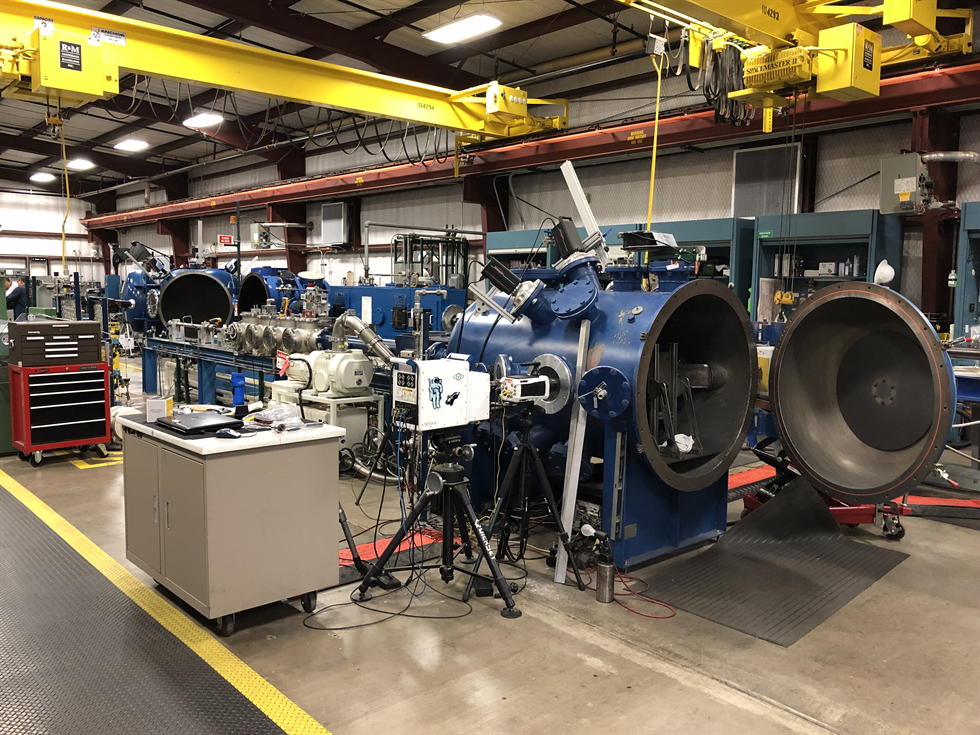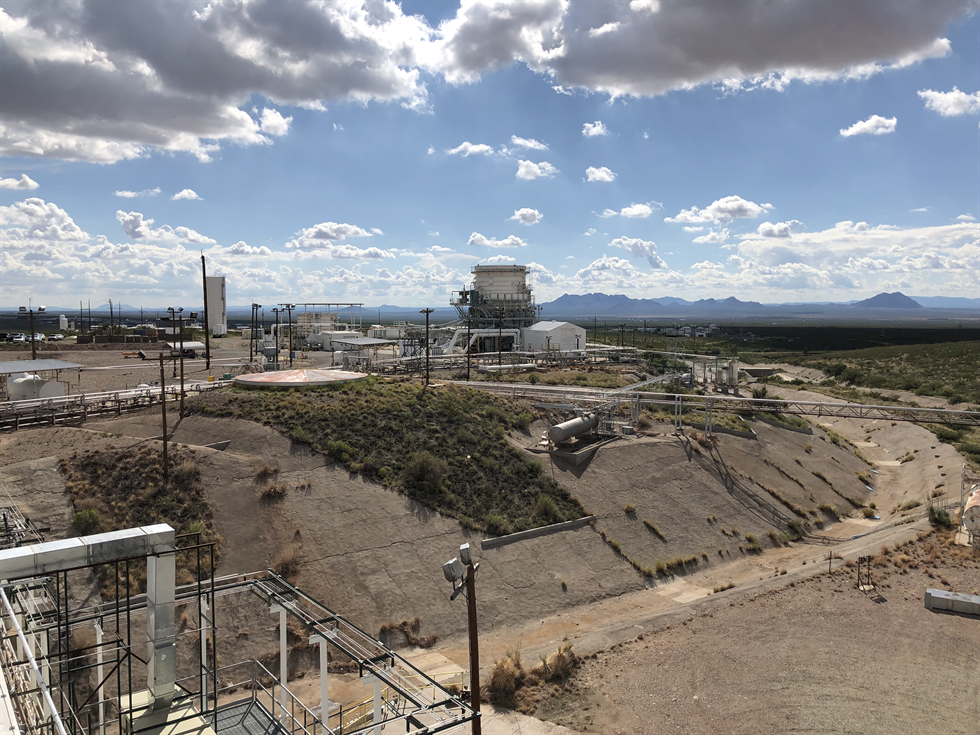Roundup Presents: The Directors Series (RA)
In the Deserts of New Mexico
Located on the southwest corner of the U.S. Army’s White Sands Missile Range in south central New Mexico, NASA’s White Sands Test Facility (WSTF) is not often in the spotlight, but continues to play a leading role in the testing of spacecraft systems and hardware that enable continued success on the International Space Station and preparation to launch astronauts to the Moon.
WSTF was constructed in the western foothills of the San Augustin Mountains in 1963 as a test site for the Apollo Command and Service Module and the Lunar Excursion Module’s ascent and descent stages. The remote location made it a prime location to conduct testing on hypergolic propellants, which are extremely toxic and corrosive fluids used in rocket engines for propulsion and hydraulic power.
“What is our reason for existing out here in the desert?” said Bob Cort, the site manager for WSTF. “Our primary (reason) is to conduct hazardous testing that supports NASA programs.”
Cort, who started as a contractor employee right out of college
and now oversees the facility’s 600 employees, is responsible for the technical
oversight of the facility’s hazardous test activities. Under his leadership, WSTF
has been able to grow their capabilities and cement their role as agency
leaders in designing and conducting hazardous testing for human spaceflight
missions.
The facility, which is managed by NASA’s Johnson Space Center, is heavily involved in testing in support of human spaceflight missions. These capabilities have been on full display as NASA gears up for missions to the Moon with the Artemis program.
“(Deputy Program Manager for Orion) Charlie Lindquist described it best when he said, ‘The path to the Moon and on to Mars goes through White Sands,’” Cort said. “To fly crews safely to the Moon, we need to conduct some of the critical spacecraft testing right here in the desert.”
The integral role that WSTF plays in the larger Artemis picture was on full display in August during an abort-to-orbit test for the Orion spacecraft. During the evaluation, the propulsion systems on the spacecraft’s European Service Module demonstrated that in the event of an abort scenario, the crew could safely be brought into a temporary orbit that would allow time to evaluate the crew and spacecraft before a decision to either continue with an alternate mission profile, or return to Earth, could be made.
This analysis required a remote location due to potential
safety hazards, but it also relied on the technical experts at WSTF to unite
with NASA’s international partners to prepare a test stand that enabled a full
stress test of the engines. WSTF will likely play a key role in the lead-up to
Artemis with continued testing for Orion, as well descent and ascent vehicles for
commercial lunar payload service vehicles.
“I see our role in the Artemis program continuing to expand as we continue development of the Gateway and landing systems,” Cort said. “Additionally, as we develop and refine those capabilities, we will be able offer those services to commercial providers. That means that we are able to help them be more agile and achieve goals more quickly, just like we are doing with the Commercial Crew Program.”
Cort is keen to focus on the ability to explore new ways of designing and conducting tests, including uniting with commercial partners to offer those services. It has been a major area of success for WSTF as of late.
As NASA prepares to return launch capabilities to U.S. soil, Boeing has leveraged the experts and the location of WSTF to perform successful launch-abort engine testing for the CST-100 Starliner. WSTF will also support the company’s plans to conduct a pad-abort test at the Missile Range later this year.
The fact that commercial providers such as Boeing choose to partner with WSTF rather than build their own facilities is a point of pride for Cort, who believes it highlights their unique capabilities.
“It’s extremely important and impressive,” Cort said. “It means that we are able to provide the best value, because that commercial provider is making a business decision about how they are going to get the work done. It illustrates to me that we are a good value to the government.”
While this commercial testing is taking place in preparation for the launch of commercial crew missions to the space station, this is far from the first time WSTF has enabled human spaceflight success.
The facility plays a key role conducting the agency’s Flight Acceptance Standard Testing (FAST) and Hypervelocity Impact Testing (HVIT). With FAST, the WSTF team tests most materials that will launch to station to ensure that it qualifies with NASA’s flammability and toxic off-gas standards. HVIT, meanwhile, makes it possible to simulate orbital debris impacts, leading to safer designs and a greater understanding of the low-Earth orbit environment.

Example of HVIT testing conducted on sheets of metal to simulate a orbital debris impact.
Developing, refining and testing these capabilities has made
the WSTF team not only the technical experts, but also the safety experts in
many areas of spaceflight testing.
“One of the things that come out of hands-on testing is that you learn by doing, and when you learn by doing you become pretty darn good at it,” Cort said. “And, because our team is so skilled, passionate and safe, they love to share their knowledge and teach other people about how to conduct testing safely.”
They have leveraged this capability to design robust safety trainings for NASA, other government agencies and commercial providers, enabling others to safely work on research and testing and unite with NASA to develop new capabilities for human spaceflight and benefits on Earth.
Cort (center, purple tie) on a tour of WSTF with Johnson center director Mark Geyer (left, gold tie).
One example is the WSTF Composite Overwrapped Pressure Vessel (COPV) testing team becoming the government and industry leader in COPV testing safety. COPVs are vessels composed of carbon fiber composite wrapped over an aluminum liner, which are designed to hold gas under high pressure. Due to their light weight and strength, these vessels offer huge benefits to spaceflight — but there is still much to learn about working with them safely.
WSTF has become the leader in inspection, damage tolerance and HVIT testing on the vessels to understand how they operate in harsh environments. And, what WSTF personnel have learned through testing they now deliver to commercial partners with necessary safety trainings, enabling them to safely work with COPVs and continue to develop and refine the technology.
With their expertise, WSTF is playing a major role in returning astronauts to the Moon, and they continue to push the envelope in the development and innovation of spaceflight. Although they have a lot going on, Cort knows that his team is engaged and excited for the next steps in human space exploration and fully focused on the safety of our astronauts.

“I think the hands-on nature of our work really connects us to the mission,” Cort said. “Dealing with real flight hardware, and knowing that the work that we do directly impacts the safety of the crew and the success of missions, keeps us motivated, engaged and excited.”
That excitement is sure to grow as NASA moves toward the Moon. And while WSTF may not be the most well-known NASA facility to the public, it is only becoming more important to the mission as other destinations further in our solar system beckon us from afar. The path to the Moon goes through White Sands.
Noah J. Michelsohn, Johnson Space Center

Robert Cort is director of NASA's White Sands Test Facility, managed by Johnson Space Center and located in White Sands, New Mexico. This story is part 14 of The Directors Series, highlighting Johnson’s mission of Dare. Unite. Explore. Stay tuned for stories from each directorate and find previous stories on the directors website.



















